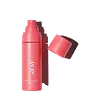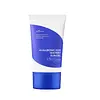What's inside
What's inside
 Key Ingredients
Key Ingredients

 Benefits
Benefits

 Concerns
Concerns

No concerns
 Ingredients Side-by-side
Ingredients Side-by-side

Water
Skin ConditioningPhenylbenzimidazole Sulfonic Acid
UV AbsorberTerephthalylidene Dicamphor Sulfonic Acid
UV AbsorberPolysilicone-15
UV FilterMethylene Bis-Benzotriazolyl Tetramethylbutylphenol
UV FilterPropanediol
SolventButylene Glycol
HumectantHyaluronic Acid
HumectantVetiveria Zizanoides Root Extract
PerfumingSaccharomyces/Rice Ferment Filtrate
Skin ConditioningWithania Somnifera Root Extract
Skin ConditioningPrunus Yedoensis Leaf Extract
Skin ConditioningPhenoxyethanol
PreservativeSodium Gluconate
Skin ConditioningWater, Phenylbenzimidazole Sulfonic Acid, Terephthalylidene Dicamphor Sulfonic Acid, Polysilicone-15, Methylene Bis-Benzotriazolyl Tetramethylbutylphenol, Propanediol, Butylene Glycol, Hyaluronic Acid, Vetiveria Zizanoides Root Extract, Saccharomyces/Rice Ferment Filtrate, Withania Somnifera Root Extract, Prunus Yedoensis Leaf Extract, Phenoxyethanol, Sodium Gluconate
Water
Skin ConditioningButylene Glycol
HumectantEthylhexyl Salicylate
UV AbsorberHomosalate
Skin ConditioningDibutyl Adipate
EmollientNiacinamide
SmoothingBis-Ethylhexyloxyphenol Methoxyphenyl Triazine
Skin ConditioningCyclopentasiloxane
EmollientMethylene Bis-Benzotriazolyl Tetramethylbutylphenol
UV FilterPolysilicone-15
UV FilterDiethylamino Hydroxybenzoyl Hexyl Benzoate
UV Filter1,2-Hexanediol
Skin ConditioningPentylene Glycol
Skin ConditioningPinus Pinaster Bark Extract
AntioxidantCeramide NP
Skin ConditioningCentella Asiatica Extract
CleansingGlycerin
HumectantPortulaca Oleracea Extract
Skin ConditioningHouttuynia Cordata Extract
Skin ConditioningOlea Europaea Fruit Oil
MaskingFicus Carica Fruit Extract
HumectantSodium Hyaluronate
HumectantCeteth-10
EmulsifyingHydrogenated Lecithin
EmulsifyingDecyl Glucoside
CleansingPropanediol
SolventTocopherol
AntioxidantAstaxanthin
Skin ConditioningHyaluronic Acid
HumectantSodium Hyaluronate Crosspolymer
HumectantAscorbyl Propyl Hyaluronate
Skin ConditioningHydrolyzed Hyaluronic Acid
HumectantHydroxypropyltrimonium Hyaluronate
Acrylates/C10-30 Alkyl Acrylate Crosspolymer
Emulsion StabilisingSodium Acetylated Hyaluronate
HumectantHydrolyzed Sodium Hyaluronate
Skin ConditioningAdenosine
Skin ConditioningXanthan Gum
EmulsifyingCetyl PEG/PPG-10/1 Dimethicone
EmulsifyingTromethamine
BufferingCarbomer
Emulsion StabilisingPropylene Glycol
HumectantEthylhexylglycerin
Skin ConditioningWater, Butylene Glycol, Ethylhexyl Salicylate, Homosalate, Dibutyl Adipate, Niacinamide, Bis-Ethylhexyloxyphenol Methoxyphenyl Triazine, Cyclopentasiloxane, Methylene Bis-Benzotriazolyl Tetramethylbutylphenol, Polysilicone-15, Diethylamino Hydroxybenzoyl Hexyl Benzoate, 1,2-Hexanediol, Pentylene Glycol, Pinus Pinaster Bark Extract, Ceramide NP, Centella Asiatica Extract, Glycerin, Portulaca Oleracea Extract, Houttuynia Cordata Extract, Olea Europaea Fruit Oil, Ficus Carica Fruit Extract, Sodium Hyaluronate, Ceteth-10, Hydrogenated Lecithin, Decyl Glucoside, Propanediol, Tocopherol, Astaxanthin, Hyaluronic Acid, Sodium Hyaluronate Crosspolymer, Ascorbyl Propyl Hyaluronate, Hydrolyzed Hyaluronic Acid, Hydroxypropyltrimonium Hyaluronate, Acrylates/C10-30 Alkyl Acrylate Crosspolymer, Sodium Acetylated Hyaluronate, Hydrolyzed Sodium Hyaluronate, Adenosine, Xanthan Gum, Cetyl PEG/PPG-10/1 Dimethicone, Tromethamine, Carbomer, Propylene Glycol, Ethylhexylglycerin
 Reviews
Reviews

Ingredients Explained
These ingredients are found in both products.
Ingredients higher up in an ingredient list are typically present in a larger amount.
Butylene Glycol (or BG) is used within cosmetic products for a few different reasons:
Overall, Butylene Glycol is a safe and well-rounded ingredient that works well with other ingredients.
Though this ingredient works well with most skin types, some people with sensitive skin may experience a reaction such as allergic rashes, closed comedones, or itchiness.
Learn more about Butylene GlycolHyaluronic acid is naturally found in healthy skin. It is a humectant, meaning it draws moisture to your skin.
This ingredient helps hydrate, soothe, and protect the skin.
What makes hyaluronic acid so hydrating? It has the capacity to bind or hold large amounts of water.
Fun fact: It is already naturally found in our bodies, such as the fluids of our eyes and our joints.
Studies find this ingredient to have anti-inflammatory and anti-microbial properties. This can help speed up wound-healing.
Hyaluronic acid can be irritating if the molecule has a low-molecular weight, or if the molecules are small.
One study found low-molecular weight hyaluronic acid to be pro-inflammatory, meaning some people may experience irritation. This is because our bodies use hyaluronic acid in the wound-healing process to signal to our bodies, via irritation, that something needs healing.
The same study found high-molecular weight hyaluronic acid to be anti-inflammatory.
These are some other common types of Hyaluronic Acid:
Learn more about Hyaluronic AcidMethylene Bis-Benzotriazolyl Tetramethylbutylphenol (Tinosorb M) is a hybrid and broad-spectrum UV ingredient. It is both a UV absorber and filter.
UV absorbers are an agent that absorbs UV rays. They protect your skin by using chemical reactions to convert UV rays into heat and energy. UV filters physically reduce the amount of UV rays from reaching your skin.
Tinosorb M covers a range of 280-400 nm and is photostable. This ingredient is neither oil or water soluble.
Tinosorb M is not available in the US. However, it is available in the EU and Asia.
It's sister, Tinosorb S, is set to be approved in the US by late 2025 (fingers crossed!).
Learn more about Methylene Bis-Benzotriazolyl TetramethylbutylphenolPolysilicone-15 is a chemical UV filter that absorbs UV-B rays.
It is a photostable ingredient used to boost SPF factor and protect products from UV-induced deterioration.
This ingredient is not water-soluble.
Learn more about Polysilicone-15Propanediol is an all-star ingredient. It softens, hydrates, and smooths the skin.
It’s often used to:
Propanediol is not likely to cause sensitivity and considered safe to use. It is derived from corn or petroleum with a clear color and no scent.
Learn more about PropanediolWater. It's the most common cosmetic ingredient of all. You'll usually see it at the top of ingredient lists, meaning that it makes up the largest part of the product.
So why is it so popular? Water most often acts as a solvent - this means that it helps dissolve other ingredients into the formulation.
You'll also recognize water as that liquid we all need to stay alive. If you see this, drink a glass of water. Stay hydrated!
Learn more about Water